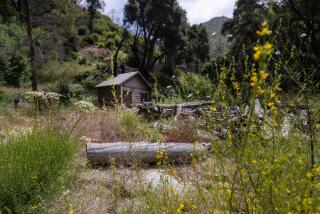Lopez Canyon: The Belly of the Beast
Find the sea gulls hovering much too far inland, and you find Lopez Canyon, the nether end of our civic intestinal tract.
Trash trucks--250 of them a day, five days a week, rumbling like over-satisfied bellies-- make the caravan climb to disgorge the profligate leftovers, the disposables and expendables and indigestibles of Los Angeles.
Each day, 3,400 tons end up here, nearly two pounds a day for every Angeleno--four, five times our body weight every year. Two pounds measured out in pizza boxes and dirty diapers and Ed McMahon sweepstakes mail and microwave dishes and--this week’s special--NFL playoff chip bags and dip cartons.
Lopez Canyon Landfill is the last city-owned dump, and C Canyon is the last dumping site in Lopez Canyon. After A, B, B-plus and C sites, one expects that there would remain the rest of the alphabet’s worth of canyons to fill.
But Lopez Canyon’s 396 acres of scalped brown escarpments and gullies, which were to have been shut down five years ago, will end life as the city’s garbage maw on July 1.
Your two pounds a day, my two pounds, will stop coming here. But they will not stop coming.
*
The city was using metal trash cans that clanged like brass wind chimes when Turner L. Johnson started at the sanitation department. Thirty-five years later, two months from retirement, he runs Lopez Canyon, and looks tough enough yet to hoist a trash can.
In 1961, the city’s inedibles were dumped in dumps--so they were called before the word, noun and verb, became unsavory. The garbage was sent to the hog farms of the San Fernando Valley. That, says Johnson, was our recycling.
Sam Yorty won the mayoralty of Los Angeles on the strength of his gallant opposition to the city’s first feeble recycling effort. Housewives--another word fallen from favor--should not be coerced, he declared, into separating out metal cans once a month.
Any issue that can get people mad enough to vote must be political plutonium, and so it has been since, from the ferocious opposition that killed the LANCER trash-to-energy incinerator, to Lopez Canyon in Lake View Terrace.
It lies at the edge of the city, in Richard Alarcon’s councilmanic district. The fact that some of the most vehement complaints about smell and runoff and noise came from Kagel Canyon, which is not in the city but the county, demonstrates that environmental yuck honors no boundaries, NAFTA or no NAFTA.
At Lopez Canyon, the city can compact trash, and reorder and cover up and landscape, and it does. It can line the earth with protective plastic, and web the hillsides with blue pipes and brown pipes to draw off methane and water, and enclose the waste, like the dead, in clay.
The city can host neighborhood hazmat collections like Tupperware parties, and still, because hazardous waste doesn’t always come marked with skull and crossbones, landfill workers must wade through each day’s detritus to retrieve domestic hazmat--nail polish and flashlight batteries and oven cleaner.
We still expect trash to be taken care of, invisibly, like potholes or electricity. Garbage in, garbage out--somehow. The thread from our designer wastebaskets to the stinking, glittering pile at Lopez Canyon still eludes us, as a different one eluded the young woman in Washington, confronting the tractors of a farm-price protest a decade ago, who declared, “I don’t need you farmers--I get my food at the grocery store!”
*
The dump of my childhood was a liability lawyer’s paradise: obstacle courses of old tires, tin cans to be shot at, empty bottles of Old Granddad to be sniffed--lockjaw and broken arms waiting to happen. We set off the Fourth of July fireworks at the dump so if anything caught fire, it wouldn’t do much damage.
That’s how most dumps end up in the poorest neighborhoods, says Councilman Alarcon--put ‘em where they won’t damage the prosperous folks. To fault that is not NIMBY-ism, he says, but environmental justice, and it isn’t just poor people and it isn’t just landfills; an Arco pipeline project is heading right through the heart of the 7th District, and he’ll stand against that too.
When Lopez Canyon closes in July, the trash it takes must go to private landfills. This will cost money, some of which will be made up by charging $5 a month to residents who can’t confine their trash to the two containers. They can, of course. Some already do. And yet there in C Canyon, scattered in heaps, are soda bottles and beer cans and plain paper, all of which can be recycled by the city.
It grieves me to throw anything away, foam cups especially; I write my name on them imagining that someday, archeological scholars will devote whole careers to divining whom these votive chalices were dedicated to.
It’s the closest I shall come to immortality, almost as close as the trash that galls Turner Johnson most: “Those little plastic grocery bags that are like parachutes.” Across the blades of the trash bulldozers, across the face of L.A., they drift like puffs of thistledown, durable as the dinosaurs.
Russia, said Churchill, is a riddle wrapped in a mystery inside an enigma. America is plastic within paper inside shrink-wrap, as lavish in its waste as in its consumption.
More to Read
Sign up for Essential California
The most important California stories and recommendations in your inbox every morning.
You may occasionally receive promotional content from the Los Angeles Times.











